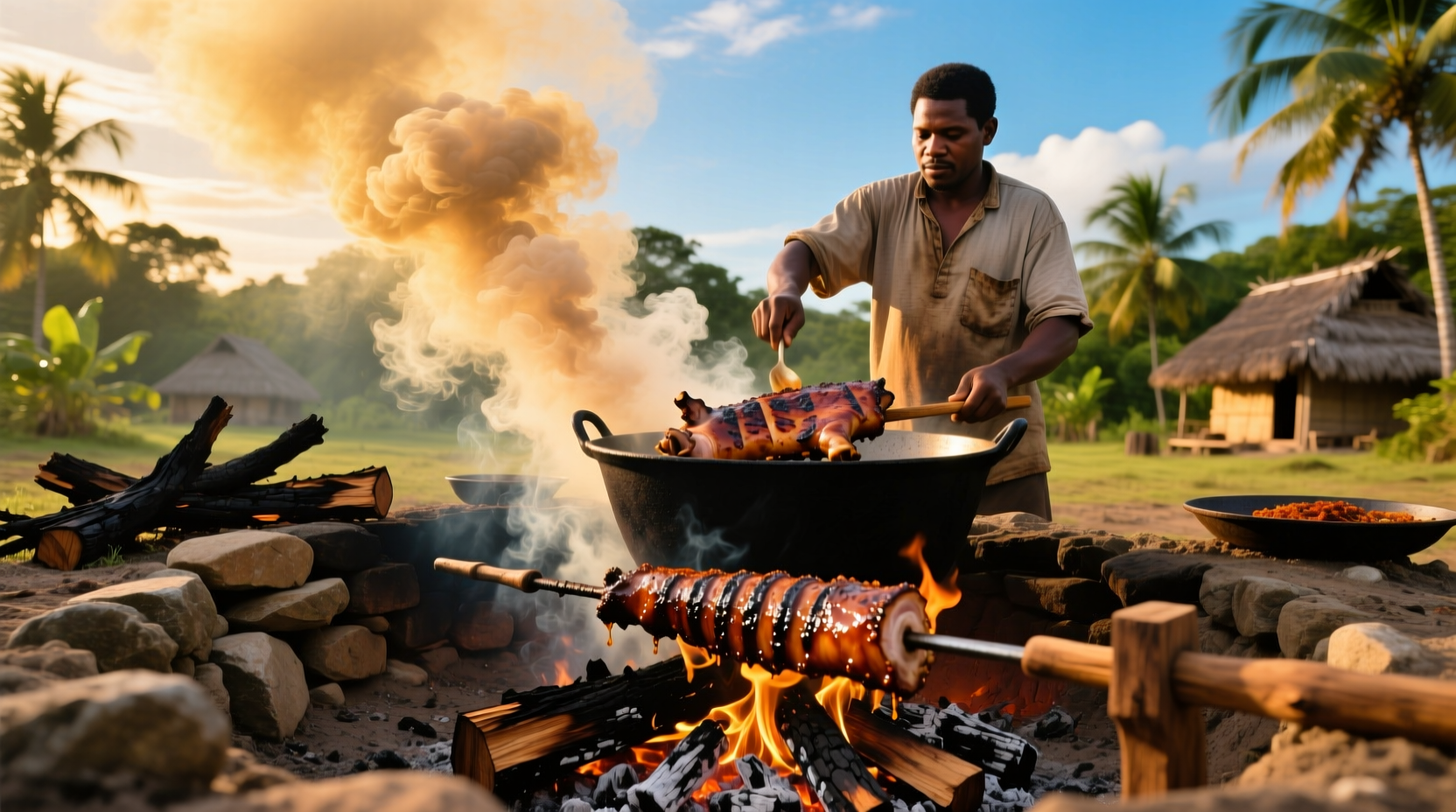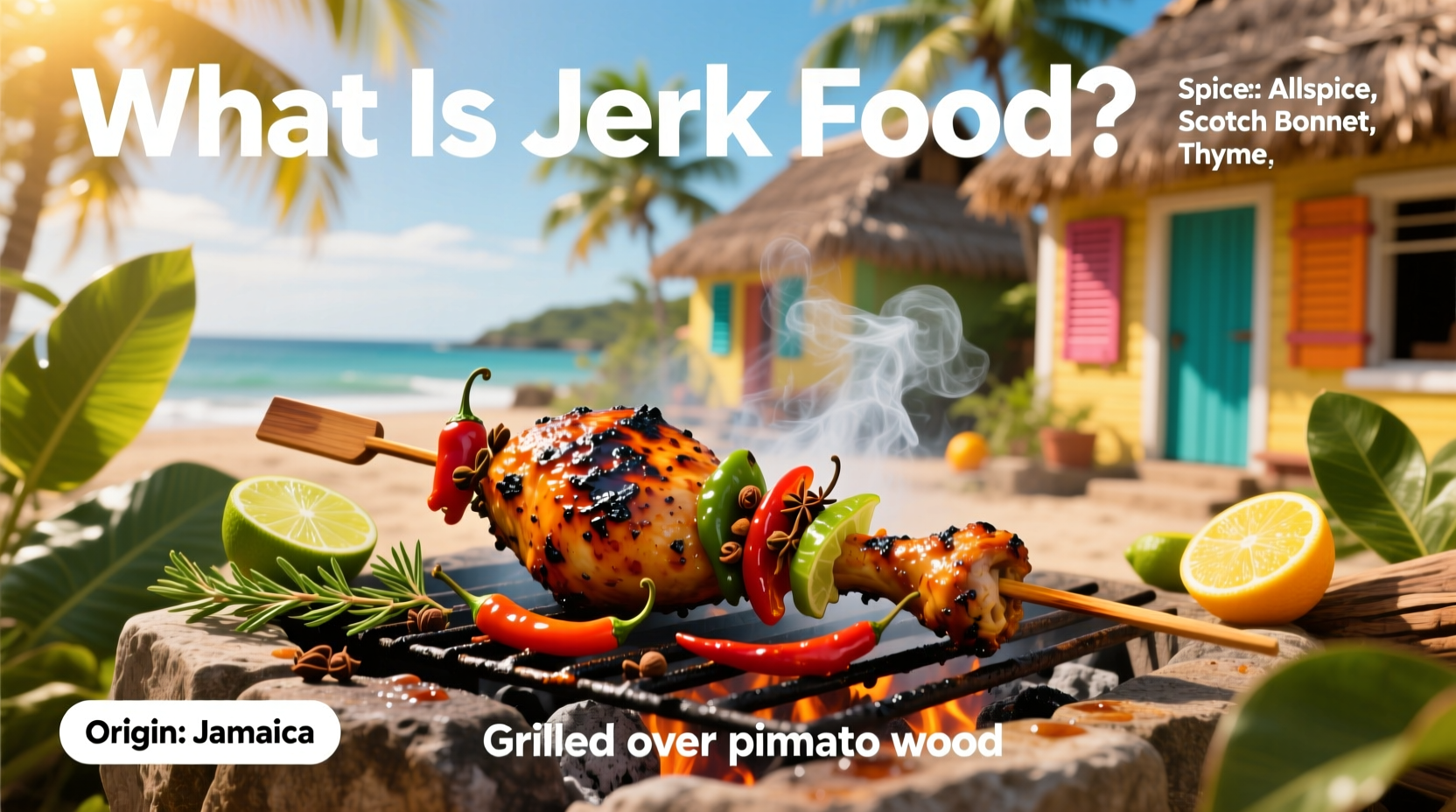The Roots of Jerk: More Than Just Spicy Food
When you ask what is jerk food, you're exploring one of the Caribbean's most fascinating culinary traditions. Far beyond being "just spicy," jerk represents Jamaica's cultural fusion and survival ingenuity. The term "jerk" likely derives from the Spanish "charqui" (dried meat), evolving through Jamaican Patois to describe the pulling and tearing technique used to prepare meat before modern knives were available.
From Survival Technique to Global Sensation: A Historical Timeline
Understanding jerk food's evolution reveals why it's cherished worldwide. This cooking method wasn't born in restaurants but from necessity:
| Period | Development | Cultural Significance |
|---|---|---|
| Pre-1500s | Taino indigenous people used pimento wood smoke to preserve meat | Survival technique against tropical spoilage |
| 1600s-1700s | Maroon communities (escaped slaves) combined Taino methods with African spices | Preservation method while evading capture in Jamaica's mountains |
| 1940s-1960s | Jamaican roadside stands began commercializing jerk cooking | Transition from survival food to cultural staple |
| 1980s-Present | Global spread through Jamaican diaspora and tourism | Recognition as UNESCO intangible cultural heritage element |
What Makes Jerk Food Authentic: Beyond the Heat
Many confuse jerk with simply "spicy food," but authentic jerk preparation involves specific elements that distinguish it from other spicy cuisines:
The Essential Jerk Components
- Pimento wood - The heart of authentic jerk, providing allspice berry smoke (not just ground allspice)
- Scotch bonnet peppers - Used whole for flavor depth, not just heat
- Slow cooking - Traditionally over low heat for hours, not grilled quickly
- Marination time - Minimum 24 hours for proper flavor penetration
Jerk vs. Common Misconceptions
Understanding what jerk food isn't helps clarify its true nature. Many commercial "jerk" products miss the mark:
| Authentic Jerk | Common Misconceptions |
|---|---|
| Slow-cooked over pimento wood smoke | Quickly grilled with generic charcoal |
| Complex flavor profile (sweet, smoky, spicy) | Primarily hot with one-dimensional heat |
| Traditional meats: goat, wild boar, chicken | Only chicken or pork offered |
| Marinated 24+ hours with fresh ingredients | Pre-made sauces with artificial flavors |
Experiencing Authentic Jerk: What Travelers Should Know
For those seeking genuine jerk food experiences, understanding regional variations matters. In Jamaica, the best jerk comes from specific areas where tradition remains strong:
Portland Parish in northeastern Jamaica remains jerk's spiritual home, where family-run stands still cook over pimento wood pits. The Jamaica Ministry of Culture recognizes Boston Bay as jerk's birthplace, where cooking methods have changed little since the 17th century. When evaluating jerk authenticity, look for these markers:
- Smoke that's grayish-white (indicates proper pimento wood)
- Meat with dark, caramelized crust but moist interior
- Flavor that builds gradually rather than immediate burn
- Accompaniments like festival (sweet fried dough) or roasted breadfruit

Bringing Jerk Home: Practical Tips for Authentic Flavor
You don't need to travel to Jamaica to enjoy quality jerk. While nothing replicates the traditional pit method, home cooks can achieve satisfying results:
Essential Jerk Preparation Guidelines
- Marinate properly - Minimum 24 hours for chicken, 48 for tougher meats
- Balance heat - Use whole Scotch bonnets (not just seeds) for complex flavor
- Smoke matters - Add allspice berries to smoking chips if using grill
- Cook low and slow - 275°F for 3-4 hours yields best texture
For those without access to fresh pimento wood, the USDA Agricultural Research Service confirms that combining allspice berries with guava wood creates the closest approximation to traditional smoke flavor.
Why Jerk Food Matters: Cultural Preservation Through Cuisine
Jerk represents more than cooking technique—it's a living history of resistance, adaptation, and cultural preservation. The Maroon communities who perfected jerk were fighting for freedom while maintaining their culinary identity. Today, as commercial versions flood global markets, supporting authentic jerk providers helps preserve this cultural heritage.
When you understand what jerk food truly is—a complex interplay of indigenous knowledge, African culinary traditions, and Caribbean resourcefulness—you gain appreciation beyond just the flavor. This knowledge helps identify genuine jerk experiences and honors the centuries of innovation behind each bite.
What does jerk mean in Jamaican cooking?
In Jamaican cooking, jerk refers to both the spice marinade and the slow-cooking technique over pimento wood. The term likely evolved from the Spanish "charqui" (dried meat) through Jamaican Patois, describing the pulling and tearing method used to prepare meat before modern knives were available.
Is jerk food just spicy or does it have other flavors?
Authentic jerk food features a complex flavor profile beyond just heat. The allspice provides warm, sweet notes, thyme adds earthiness, scallions contribute freshness, and the slow smoking creates deep umami. Proper jerk should have balanced heat that builds gradually rather than immediate burning sensation.
What's the difference between jerk seasoning and jerk cooking?
Jerk seasoning refers to the spice blend alone, while jerk cooking encompasses the entire preparation method including marinating time, specific wood for smoking, and slow-cooking technique. Authentic jerk requires both the proper seasoning and traditional cooking method to achieve its distinctive flavor and texture.
Can jerk food be made without Scotch bonnet peppers?
While Scotch bonnet peppers are traditional, authentic jerk flavor can be approximated with habaneros as substitute. However, completely removing these peppers creates a different flavor profile. The key is using whole peppers (not just seeds) for complex heat rather than just maximum spiciness.
Why is pimento wood essential for authentic jerk?
Pimento wood comes from the allspice tree, which is native to Jamaica. When burned, it releases the same aromatic compounds found in allspice berries, creating a flavor infusion that ground spices alone cannot replicate. This smoking method was developed for meat preservation and remains central to jerk's distinctive taste.











 浙公网安备
33010002000092号
浙公网安备
33010002000092号 浙B2-20120091-4
浙B2-20120091-4